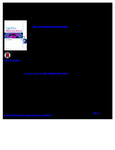Peripheral cues and gaze direction jointly focus attention and inhibition of return
| dc.contributor.author | Hudson, Matthew | |
| dc.contributor.author | Skarratt, PA | |
| dc.date.accessioned | 2021-08-20T17:00:50Z | |
| dc.date.available | 2021-08-20T17:00:50Z | |
| dc.date.issued | 2016-10-01 | |
| dc.identifier.issn | 1758-8928 | |
| dc.identifier.issn | 1758-8936 | |
| dc.identifier.uri | http://hdl.handle.net/10026.1/17632 | |
| dc.description.abstract |
Centrally presented gaze cues typically elicit a delayed inhibition of return (IOR) effect compared to peripheral exogenous cues. We investigated whether gaze cues elicit early onset IOR when presented peripherally. Faces were presented in the left or right peripheral hemifields, which then gazed upward or downward. A target appeared in one of four oblique spatial locations giving the cue and target horizontal or vertical congruency, both, or neither. After establishing that peripheral movement and gaze direction jointly facilitate target processing at short durations (200 ms: Experiment 1), IOR was evident for peripheral motion at longer time courses (800 and 2400 ms: Experiment 2). Only after 2400 ms did gaze direction additionally contribute to IOR for the specific gazed at location, showing the inverse pattern of response times to Experiment 1. The onset of IOR for gaze cues is independent from peripheral exogenous cueing but nevertheless contributes to the allocation of attention. | |
| dc.format.extent | 67-73 | |
| dc.format.medium | Print-Electronic | |
| dc.language | en | |
| dc.language.iso | eng | |
| dc.publisher | Informa UK Limited | |
| dc.subject | Gaze direction | |
| dc.subject | Attention | |
| dc.subject | Facilitation | |
| dc.subject | Inhibition of return | |
| dc.subject | Peripheral vision | |
| dc.title | Peripheral cues and gaze direction jointly focus attention and inhibition of return | |
| dc.type | journal-article | |
| dc.type | Journal Article | |
| plymouth.author-url | https://www.webofscience.com/api/gateway?GWVersion=2&SrcApp=PARTNER_APP&SrcAuth=LinksAMR&KeyUT=WOS:000375476800015&DestLinkType=FullRecord&DestApp=ALL_WOS&UsrCustomerID=11bb513d99f797142bcfeffcc58ea008 | |
| plymouth.issue | 1-4 | |
| plymouth.volume | 7 | |
| plymouth.publication-status | Published | |
| plymouth.journal | Cognitive Neuroscience | |
| dc.identifier.doi | 10.1080/17588928.2015.1053444 | |
| plymouth.organisational-group | /Plymouth | |
| plymouth.organisational-group | /Plymouth/Faculty of Health | |
| plymouth.organisational-group | /Plymouth/Faculty of Health/School of Psychology | |
| plymouth.organisational-group | /Plymouth/REF 2021 Researchers by UoA | |
| plymouth.organisational-group | /Plymouth/REF 2021 Researchers by UoA/UoA04 Psychology, Psychiatry and Neuroscience | |
| plymouth.organisational-group | /Plymouth/Users by role | |
| plymouth.organisational-group | /Plymouth/Users by role/Academics | |
| dc.publisher.place | England | |
| dc.identifier.eissn | 1758-8936 | |
| dc.rights.embargoperiod | Not known | |
| rioxxterms.versionofrecord | 10.1080/17588928.2015.1053444 | |
| rioxxterms.licenseref.uri | http://www.rioxx.net/licenses/all-rights-reserved | |
| rioxxterms.type | Journal Article/Review | |
| plymouth.funder | One step ahead: Prediction of other people's behavior in healthy and autistic individuals.::ESRC |


